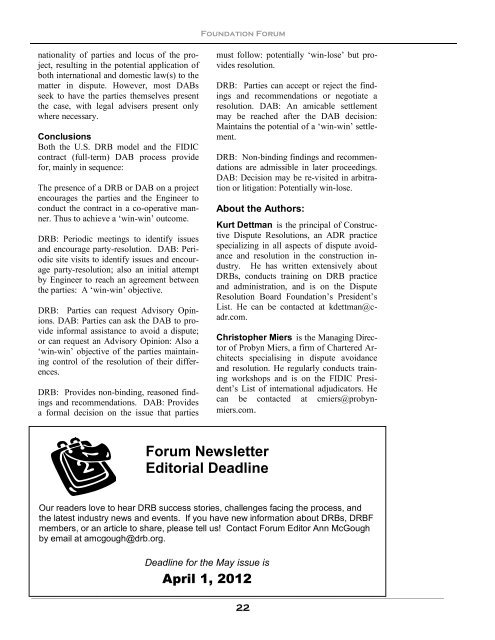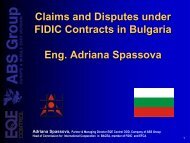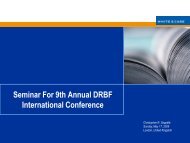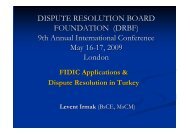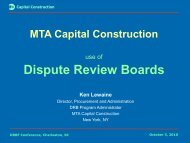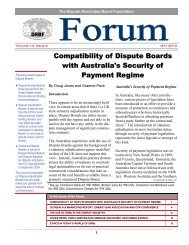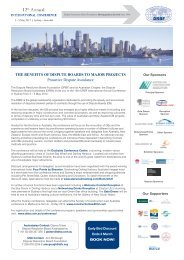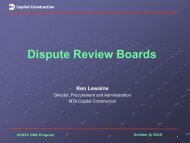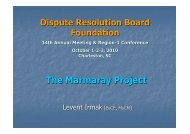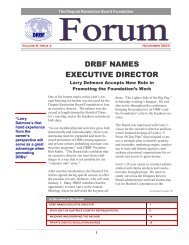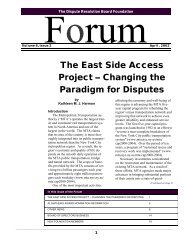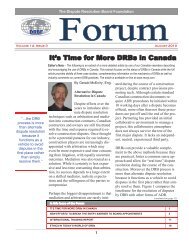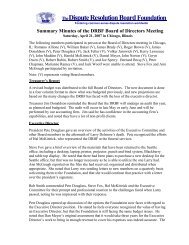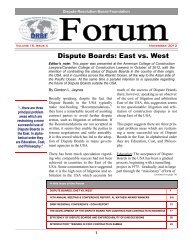DRBs Down Under - Dispute Resolution Board Foundation
DRBs Down Under - Dispute Resolution Board Foundation
DRBs Down Under - Dispute Resolution Board Foundation
You also want an ePaper? Increase the reach of your titles
YUMPU automatically turns print PDFs into web optimized ePapers that Google loves.
<strong>Foundation</strong> Forum<br />
nationality of parties and locus of the project,<br />
resulting in the potential application of<br />
both international and domestic law(s) to the<br />
matter in dispute. However, most DABs<br />
seek to have the parties themselves present<br />
the case, with legal advisers present only<br />
where necessary.<br />
Conclusions<br />
Both the U.S. DRB model and the FIDIC<br />
contract (full-term) DAB process provide<br />
for, mainly in sequence:<br />
The presence of a DRB or DAB on a project<br />
encourages the parties and the Engineer to<br />
conduct the contract in a co-operative manner.<br />
Thus to achieve a ‘win-win’ outcome.<br />
DRB: Periodic meetings to identify issues<br />
and encourage party-resolution. DAB: Periodic<br />
site visits to identify issues and encourage<br />
party-resolution; also an initial attempt<br />
by Engineer to reach an agreement between<br />
the parties: A ‘win-win’ objective.<br />
DRB: Parties can request Advisory Opinions.<br />
DAB: Parties can ask the DAB to provide<br />
informal assistance to avoid a dispute;<br />
or can request an Advisory Opinion: Also a<br />
‘win-win’ objective of the parties maintaining<br />
control of the resolution of their differences.<br />
DRB: Provides non-binding, reasoned findings<br />
and recommendations. DAB: Provides<br />
a formal decision on the issue that parties<br />
must follow: potentially ‘win-lose’ but provides<br />
resolution.<br />
DRB: Parties can accept or reject the findings<br />
and recommendations or negotiate a<br />
resolution. DAB: An amicable settlement<br />
may be reached after the DAB decision:<br />
Maintains the potential of a ‘win-win’ settlement.<br />
DRB: Non-binding findings and recommendations<br />
are admissible in later proceedings.<br />
DAB: Decision may be re-visited in arbitration<br />
or litigation: Potentially win-lose.<br />
About the Authors:<br />
Kurt Dettman is the principal of Constructive<br />
<strong>Dispute</strong> <strong>Resolution</strong>s, an ADR practice<br />
specializing in all aspects of dispute avoidance<br />
and resolution in the construction industry.<br />
He has written extensively about<br />
<strong>DRBs</strong>, conducts training on DRB practice<br />
and administration, and is on the <strong>Dispute</strong><br />
<strong>Resolution</strong> <strong>Board</strong> <strong>Foundation</strong>’s President’s<br />
List. He can be contacted at kdettman@cadr.com.<br />
Christopher Miers is the Managing Director<br />
of Probyn Miers, a firm of Chartered Architects<br />
specialising in dispute avoidance<br />
and resolution. He regularly conducts training<br />
workshops and is on the FIDIC President’s<br />
List of international adjudicators. He<br />
can be contacted at cmiers@probynmiers.com.<br />
Forum Newsletter<br />
Editorial Deadline<br />
Our readers love to hear DRB success stories, challenges facing the process, and<br />
the latest industry news and events. If you have new information about <strong>DRBs</strong>, DRBF<br />
members, or an article to share, please tell us! Contact Forum Editor Ann McGough<br />
by email at amcgough@drb.org.<br />
Deadline for the May issue is<br />
April 1, 2012<br />
———————————————————————————————————————————————————<br />
22


